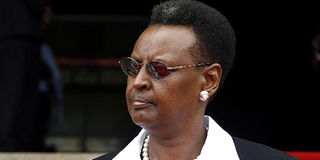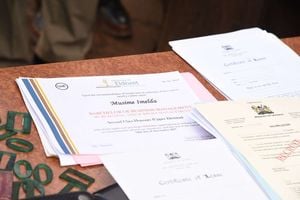The woman of power

Janet Museveni: Behind that mother-matronly public figure is an air of fear about her. Photo/FILE
In 1986, a few days after Yoweri Museveni’s National Resistance Army rebel group seized state power in Kampala, the Daily Nation published a front-page photograph of his wife Janet with the caption, Uganda’s New First Lady.
The image of a young, beautiful Mrs Museveni captured the optimism felt in Kenya — whose then leader Daniel arap Moi had taken the lead role in negotiating a settlement of the Ugandan civil war — as well as in Uganda, particularly among the south-central Bantu-speaking tribes.
Janet Keinembabazi Kataha Museveni was born in Ntungamo, western Uganda, near the Rwanda border, on August 15, 1949.
Through most of the late 1980s and 90s, she travelled the world at the side of her husband, played a public role in advancing social and charity work, becoming the most visible African First Lady after Egypt’s Susan Mubarak.
Tall and soft-spoken, she dresses traditionally and plainly, and tends towards a somewhat simplistic, New Testament view of the world, regarding herself as a Christian soldier called upon to fight the good fight for the moral revival in administrative public life.
But behind that mother-matronly public figure is an air of fear about her that pervades Ugandan society.
During the 1990s, Uganda’s news media grew bolder in their criticism of Museveni and their cartoons of the head of state and other public officials.
There was, however, one strictly observed, unwritten rule: Janet Museveni was in no way to be made the object of scrutiny or fun.
Even as a Member of Parliament who is supposed to be open to public scrutiny, Janet remains a closed book that even the most daring columnists and news commentators handle and approach with caution.
Where the general fear of the Ugandan First Lady originated is difficult to know.
But what is certain among the public is that, given a choice confronting either Museveni or his wife, he would be the easier to deal with.
Her appointment on February 16 as minister in charge of the historically impoverished and semi-arid north-eastern Karamoja region was the little discussed but much noticed highlight of the recent cabinet reshuffle.
During her 20s in the early 1970s as a ground hostess with the defunct East African Airways in Nairobi, Janet lived the full party life that would be expected of airline staff in those days.
In the 1980s after becoming First Lady, though, she grew more withdrawn, more of a disciplinarian, stern and intimidating. Her mere presence at a parliamentary session brings silence over the house.
A few weeks before the 2006 General Election, a petition was made public by the public that while she had studied for a degree in education at Kampala’s Makerere University in 1997, she did not go for the teaching practice that is a mandatory part of the condition for earning the degree.
The petition caused a sensation in the country, but faded from the news pages and broadcast airwaves as suddenly as it had appeared, never to be discussed again. Such is the power that the MP for Ruhama County in western Uganda wields in Uganda.
Unlike in Kenya where First Lady Lucy Kibaki is generally viewed as a powerful but often disruptive presence on the political scene, Janet Museveni’s behind-the-scenes hand in the unfolding events of Uganda’s political landscape has never been in question.
It is widely believed in Kampala and among political and journalistic circles that Mrs Museveni has frequently had a say — sometimes the last word — in cabinet appointments. Her views have certainly played a significant part in the shaping of domestic policy.




